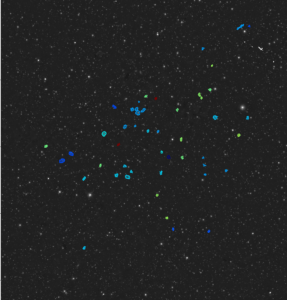An international team of astronomers has identified 49 new gas-rich galaxies utilizing the MeerKAT radio telescope in South Africa.

The 49ers – the 49 new gas-rich galaxies detected by the MeerKAT radio telescope in South Africa. Each detection is shown as colored contours, with redder colors indicating more distant gas from us and bluer colors as closer gas. The background image comes from the optical PanSTARRS survey. Image Credit: Glowacki et al. 2024
The goal of the research was to examine the star-forming gas in a single radio galaxy. Dr. Marcin Glowacki of the Curtin University node of the International Center for Radio Astronomy Research (ICRAR) in Western Australia led the study. While examining the data, Dr. Glowacki found other galaxies despite the fact that the team’s study of the galaxy produced no star-forming gas. The total gas from 49 galaxies was found.
According to Dr. Glowacki, the discovery is an excellent illustration of how exciting a tool like MeerKAT is for locating the star-forming gas in galaxies. The observations that make up the study took less than three hours and were supported by the Inter-University Institute for Data Intensive Astronomy (IDIA).
I did not expect to find almost fifty new galaxies in such a short time. By implementing different techniques for finding galaxies, which are used for other MeerKAT surveys, we were able to detect all of these galaxies and reveal their gas content.
Dr. Marcin Glowacki, International Center for Radio Astronomy Research
The colloquial term “49ers” for the new galaxies alludes to the 1849 California gold rush miners. According to Dr. Glowacki, the 49 new galaxies in the night sky are as precious as gold nuggets. Several galaxies can be identified in a single observation because they are close to one another and form galaxy groups. The gas directly connects three galaxies.
Dr. Glowacki said, “These three are particularly interesting, as by studying the galaxies at other wavelengths of light, we discovered the central galaxy is forming many stars. It is likely stealing the gas from its companion galaxies to fuel its star formation, which may lead the other two to become inactive.”
This discovery highlights the raw power of the MeerKAT telescope as an imaging instrument. The methods we developed and implemented to study the 49ers will be useful for MeerKAT large science surveys and smaller observing campaigns such as ours.
Ed Elson, Professor and Study Co-Author, University of the Western Cape
Dr. Glowacki, aided by Jasmine White, an ICRAR summer student, recently uncovered additional gas-rich galaxies by analyzing brief observations conducted by MeerKAT.
Dr. Glowacki concluded, “We hope to continue our studies and share even more discoveries of new gas-rich galaxies with the wider community soon.”
Astronomers find 49 galaxies in under three hours
Astronomers find 49 galaxies in under three hours. Video Credit: ICRAR
Journal Reference:
Glowacki, M., et al. (2024) A serendipitous discovery of H I-rich galaxy groups with MeerKAT. Monthly Notices of the Royal Astronomical Society. doi.org/10.1093/mnras/stae684